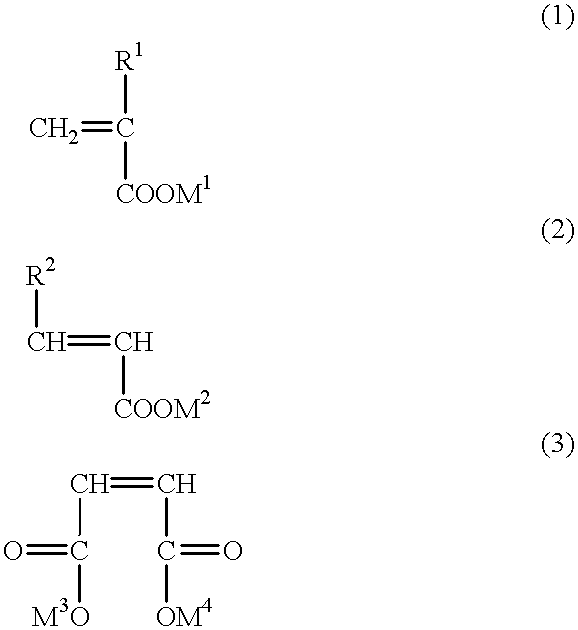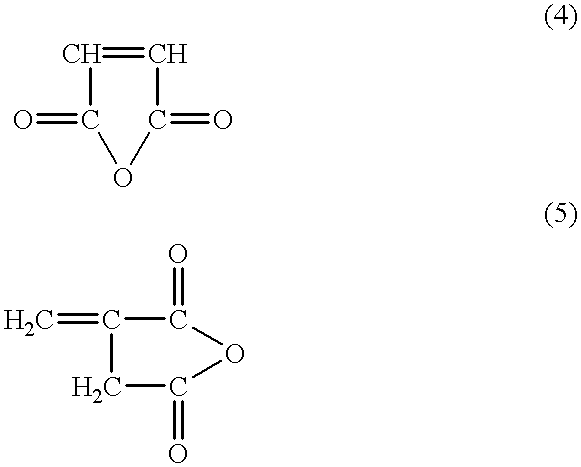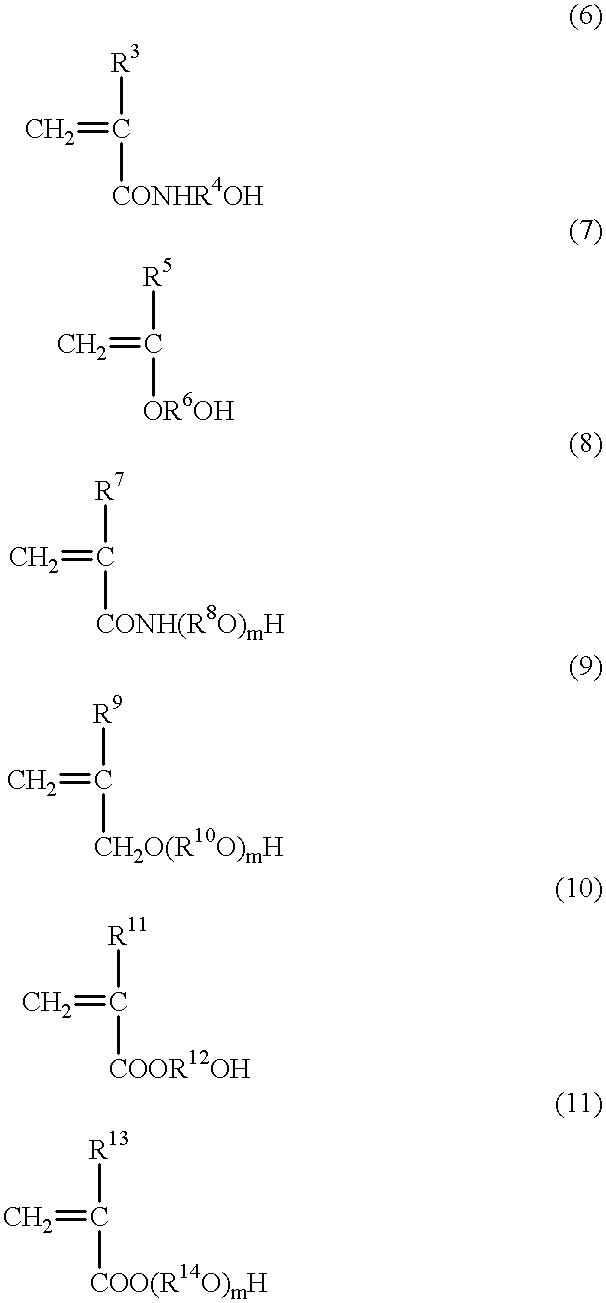Fiber product-treating agents
a technology of product treatment and fiber, which is applied in the direction of detergent compositions, detergent compounding agents, chemistry apparatus and processes, etc., can solve the problems of cumbersome operations and insufficient effect of cloths having a low content of cellulose, and achieve the effects of easy dispersal, excellent durable press configuration and durable press
- Summary
- Abstract
- Description
- Claims
- Application Information
AI Technical Summary
Benefits of technology
Problems solved by technology
Method used
Image
Examples
synthesis example 1
Synthesis of a Vinyl Copolymer a-1
114.00 g of maleic anhydride, 130.00 g of water and 116.33 g of an EO-added allyl ether [wherein the number of moles of EO added is 6] were added to a 1-L five-necked flask equipped with a stirrer, a nitrogen inlet pipe, a cooling device and a thermometer. Then, an inside of the flask was heated to the temperature of 70.degree. C. and a solution comprising 48.47 g of a 96-% sodium hydroxide dissolved in 46.53 g of water was added thereto. Further, the inside in the flask was purged (or replaced) with nitrogen and then heated to 98.degree. C. An aqueous initiator solution comprising 65.92 g of a 35-% aqueous hydrogen peroxide and 6.93 g of sodium persulfate was added dropwise to the above-mentioned reaction-flask for 6 hours and the temperature of the inside in the flask was further kept at 98.degree. C. for 4 hours. The weight average molecular weight (converted to a PEG basis) of the obtained copolymer was 21,000 as measured in the following method...
synthesis example 2
Synthesis of a Vinyl Copolymer a-2
78.40 g of maleic anhydride, 166.00 g of water and 87.60 g of an EOPO-added allyl ether [wherein the number of moles of EO added is 6 and that of PO added is 2 and which is tri-block type: allyl ether (EO).sub.2 (PO).sub.2 (EO).sub.4 ] were added to a 1-L five-necked flask equipped with a stirrer, a nitrogen inlet pipe, a cooling device and a thermometer. Then, an inside of the flask was heated to the temperature of 70.degree. C. and a solution comprising 28.33 g of a 96-% sodium hydroxide dissolved in 66.34 g of water was added thereto. Further, the inside in the flask was purged with nitrogen and then heated to 98.degree. C. An aqueous initiator solution comprising 42.74 g of a 35-% aqueous hydrogen peroxide and 4.76 g of sodium persulfate was added dropwise to the above-mentioned reaction-flask for 6 hours and the temperature of the inside in the flask was further kept at 98.degree. C. for 4 hours. The weight average molecular weight (converted t...
synthesis example 3
Synthesis of a Vinyl Copolymer a-3
156.80 g of maleic anhydride, 308.80 g of water and 152.00 g of an EOPO-added allyl ether [wherein the number of moles of EO added is 6 and that of PO added is 1 and which is tri-block type: allyl ether (EO).sub.2 (PO).sub.1 (EO).sub.4 ] were added to a 1-L five-necked flask equipped with a stirrer, a nitrogen inlet pipe, a cooling device and a thermometer. Then, an inside of the flask was heated to the temperature of 70.degree. C. and 120.00 g of a 48-% aqueous solution of sodium hydroxide were added thereto. Further, the inside in the flask was purged with nitrogen and then heated to 98.degree. C. An aqueous initiator solution comprising 85.49 g of a 35-% aqueous hydrogen peroxide and 9.53 g of sodium persulfate was added dropwise to the above-mentioned reaction-flask for 6 hours and the temperature of the inside in the flask was further kept at 98.degree. C. for 4 hours. The weight average molecular weight (converted to a PEG basis) of the obtain...
PUM
| Property | Measurement | Unit |
|---|---|---|
| temperature | aaaaa | aaaaa |
| temperature | aaaaa | aaaaa |
| temperature | aaaaa | aaaaa |
Abstract
Description
Claims
Application Information
 Login to View More
Login to View More - R&D
- Intellectual Property
- Life Sciences
- Materials
- Tech Scout
- Unparalleled Data Quality
- Higher Quality Content
- 60% Fewer Hallucinations
Browse by: Latest US Patents, China's latest patents, Technical Efficacy Thesaurus, Application Domain, Technology Topic, Popular Technical Reports.
© 2025 PatSnap. All rights reserved.Legal|Privacy policy|Modern Slavery Act Transparency Statement|Sitemap|About US| Contact US: help@patsnap.com



